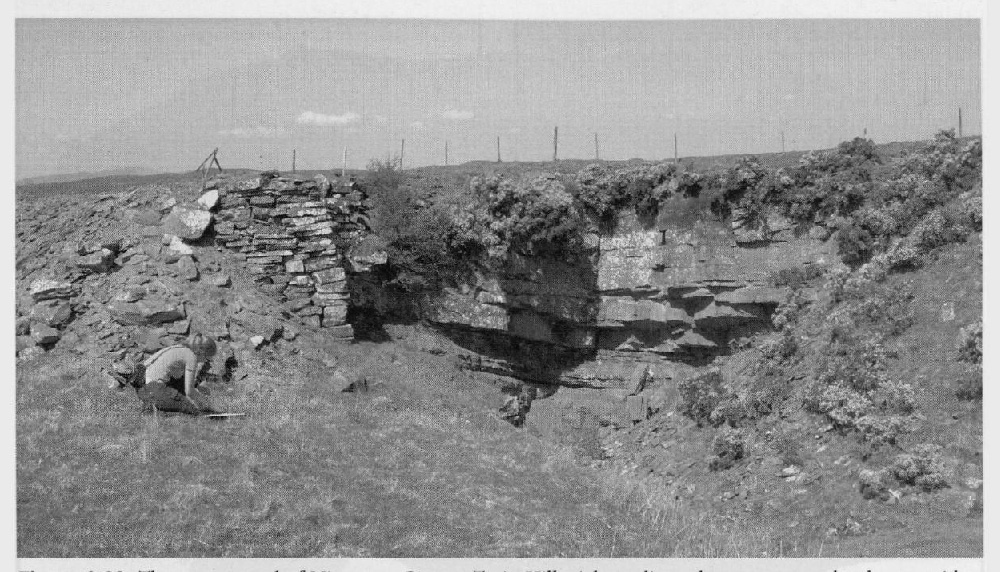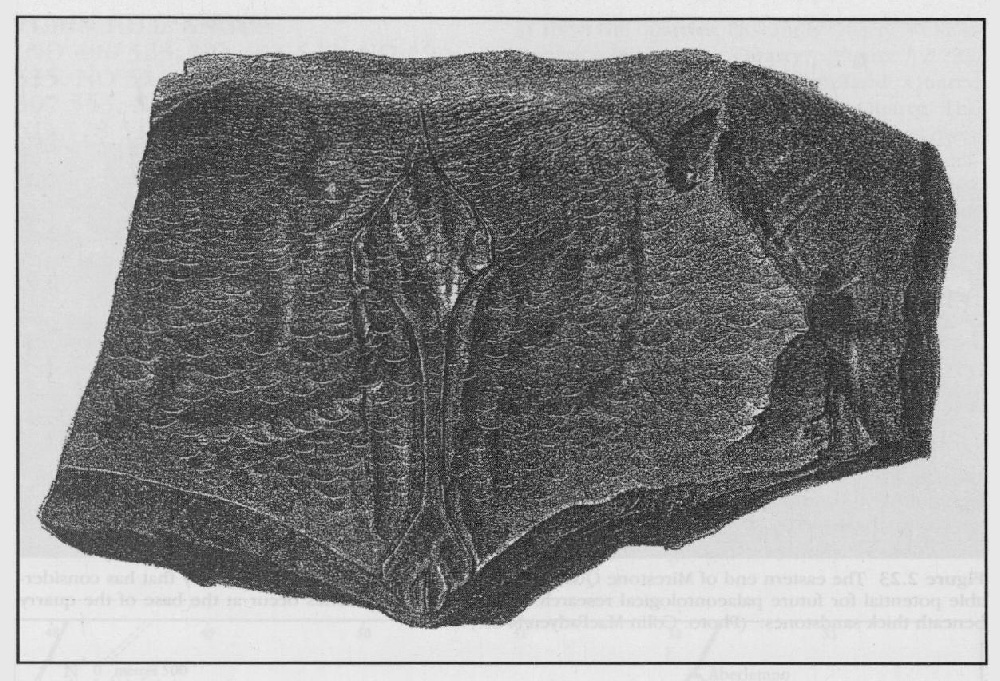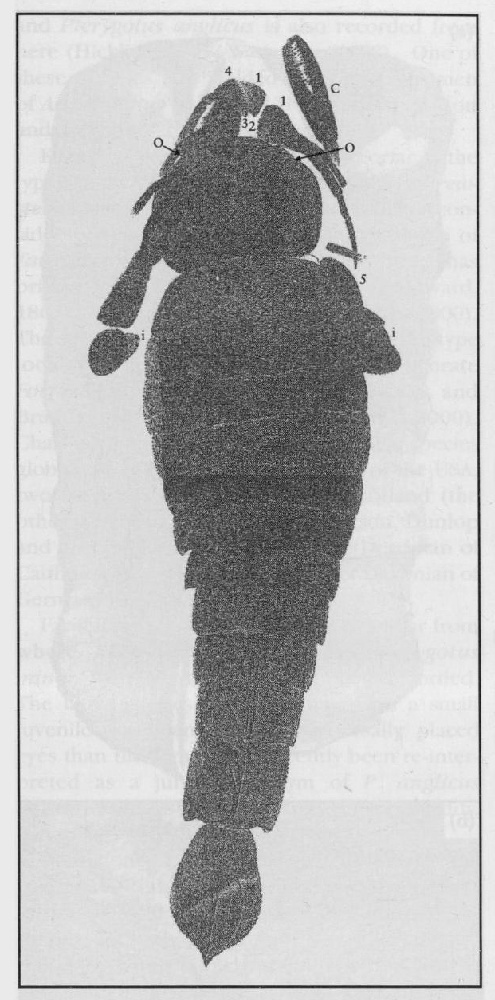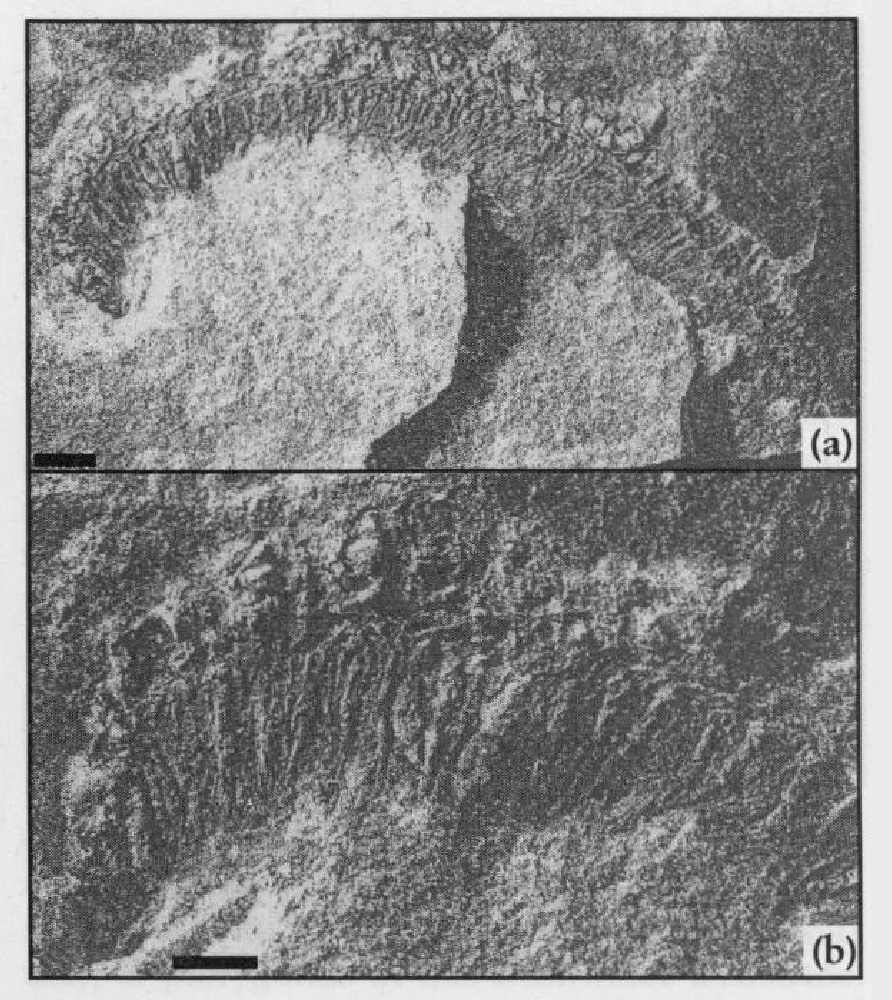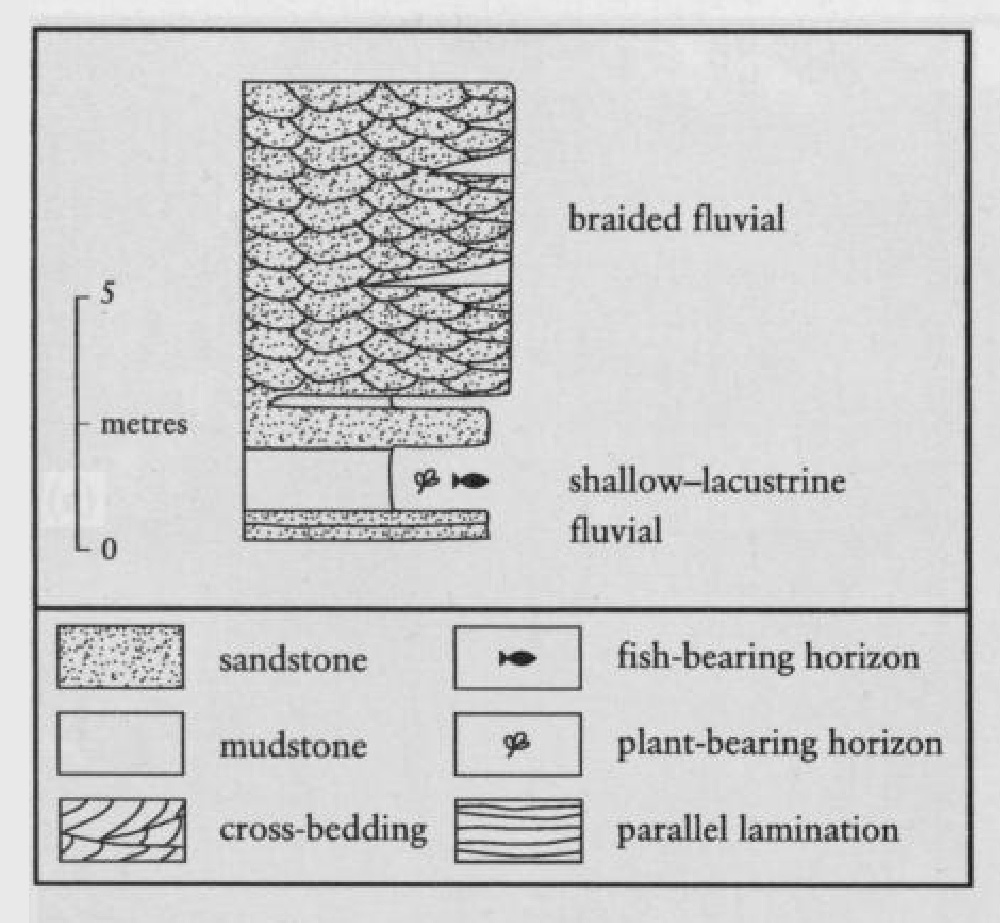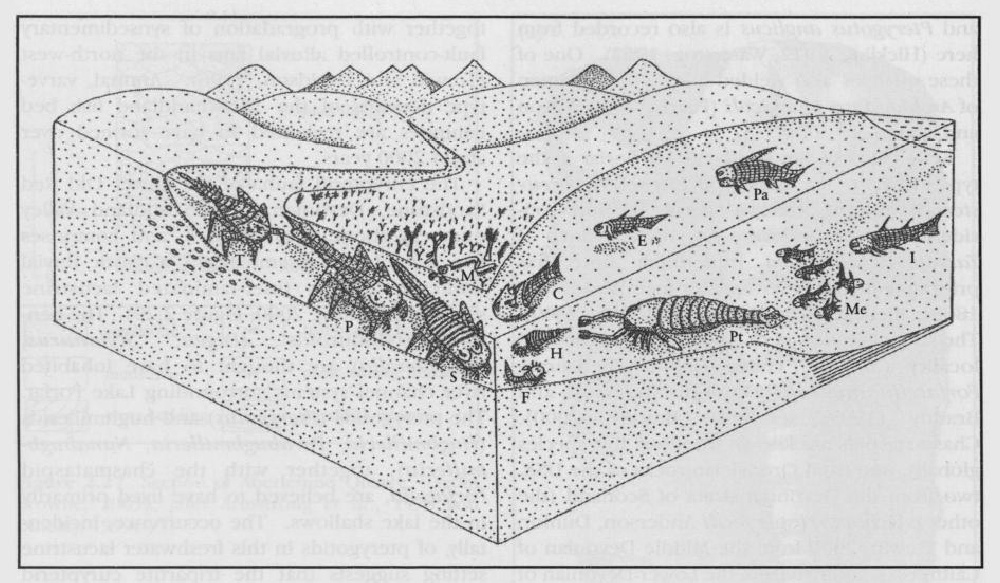Turin Hill, Angus
Derek J. Siveter
Introduction
In the north-eastern part of the Midland Valley of Scotland, about 5 km east to ENE of Forfar, lie the group of quarries that together form this composite site
The general geology, palaeontology and tectonics of the Old Red Sandstone in this part of the Midland Valley has been discussed by Hickling (1908, 1912), Mykura (1991), Armstrong and Paterson (1970), Bluck (2002) and Trewin and Thirlwall (2002) amongst others. A stratigraphical framework for the Old Red Sandstone was provided by Browne et al. (2002). Aspects of the sedimentology, biofacies and palaeoenvironment have received more detailed coverage most recently from Trewin and Davidson (1996), Bluck (2000), Browne and Barclay (2005a) and Browne (2005a,b). Also, various localities that are included in this composite Turin Hill site were described in the field guide to accompany the 1978 international symposium on the Devonian System (Armstrong et al., 1978).
Several authors have documented the arthropods from Turin Hill and associated Midland Valley localities. Page (1856a,b, 1859), Agassiz (1844), Salter (1859a), Woodward (18646, 1865a, 1866, 1872), Waterston (1962, 1964, 1975) and Braddy (2000) have discussed the eurypterids, much of the finest material of which was recovered in the nineteenth century by James Powrie. Page (1856b, 1859), Peach (1882, 1899), Rolfe (1980), Almond (1985, 1986) and Wilson and Anderson (2004) have documented millipede and kampecarid myriapods. The arthropods from here are associated with fluvial and lacustrine settings and, significantly, some are implicated with the terrestrialization of the group.
Sites on and around Turin Hill that have been included in other GCR volumes include Aberlemno Quarry, in the volumes for fossil plants, fossil fish and the Old Red Sandstone (Cleal and Thomas, 1995; Dineley and Metcalf, 1999; Barclay et al., 2005); Tillywhandland Quarry, in those for fossil fish and the Old Red Sandstone; and Clocksbriggs (also known as 'Wemyss') Quarry, which was described with Aberlemno Quarry under the site name Turin Hill' in that for fossil plants.
Description
The quarries comprising this site belong to the Arbuthnott–Garvock Group of Lower Devonian, Lochkovian and Pragian age (Browne and Barclay, 2005a). Only some of them have been logged in modern times and most have been abandoned for decades, if not a century, or more.
Undifferentiated quarries and exposures under the name "Furin Hill'
Tillywhandland Quarry
Pitscandly Quarry
Wemyss Quarry
Aberlemno Quarry
Carsegownie (or Carsgownie) Quarry
Balgavies Quarry
Other Arbuthnott–Garvock Group, Midland Valley fossil localities that have also yielded arthropods (see Armstrong and Paterson, 1970, fig. 1; Braddy, 2000, fig. 1) include the following:
Montreathmont Muir, 12 km ENE of Forfar, for eurypterids (Armstrong and Paterson, 1970; Braddy, 2000).
Canterland Den, 30 km NE of Forfar, from where P. anglicus and Kampecaris forfarensis have been listed (Peach, 1882; Hickling, 1912).
Carmyllie quarry complex, 12 km ESE of Forfar, is probably the type locality for the stylonuroid Pagea sturrocki Waterston (1962) and Pterygotus anglicus is also recorded from here (Hickling, 1912; Waterston, 1962). One of these quarries also yielded a syntype specimen of Archidesmus macnicoli (Peach, 1882; Wilson and Anderson, 2004).
Kelly Den, 18 km south-east of Forfar is the type locality of the monotypic Erieopterus brewsteri Woodward, 1864, a species recently considered to be based on a juvenile specimen of Tarsopterella scotica, but which, note, has priority over the latter species (see Woodward, 1865a; Kjellesvig-Waering, 1958; Braddy, 2000). The stream section here Is also possibly the type locality of the chasmataspid chelicerate Forfarella mitchelli Dunlop, Anderson and Braddy (1999; see also Braddy, 2000). Chasmataspids are known from just five species globally, one from Ordovician rocks of the USA, two from the Devonian strata of Scotland (the other is Achanarraspis reedi Anderson, Dunlop and Trewin, 2000 from the Middle Devonian of Caithness), and two from the Lower Devonian of Germany.
Farnell is a locality 16 km ENE of Forfar from where Pterygotus anglicus and Pterygotus minor Woodward, 1864 have been recorded. The latter species, however, based on a small juvenile specimen with more dorsally placed eyes than the former, has recently been re-interpreted as a junior synonym of P. anglicus (Woodward, 1864b; Hickling, 1912; Braddy, 2000).
Whitehouse Den, 11 km SSW of Forfar, has yielded the hughmillerid eurypterid Nanahughmilleria pygmaea Salter (1859b; see Braddy, 2000).
Balmashanner Quarry, 1 km south of Forfar, has yielded eurypterid material that probably belongs to N. pygmaea (Salter, 1859b; see Braddy, 2000).
Balruddery, 22 km south-west of Forfar, has yielded P. anglicus (Agassiz, 1844; Hickling, 1912; Salter, 1859a; Kjellesvig-Waering, 1964; Braddy, 2000) and Kampecaris forfarensis (Peach, 1892; Hickling, 1912).
Interpretation
The laminite deposits and associated fish/arthropod fauna of the Dundee Formation, Arbuthnott–Garvock Group, represent those of 'Lake Forfar', which is speculated to have formed as a result of drainage impediments to the south-west caused by local volcanic activity, together with progradation of synsedimentary fault-controlled alluvial fans in the north-west (Trewin and Davidson, 1996). Annual, varve-type deposits of the Tillywhandland fish bed laminites are reckoned to have formed over about 2000 years.
The eurypterid fauna of the Lower Old Red Sandstone, Devonian, of the Midland Valley numbers about seven species, and comprises two main facies assemblages: a clastic fluvial sequence and a finer-laminated lacustrine sequence (Braddy, 2000;
The morphology of Pterygotus and Hughmilleria in general indicates that they were active, nektonic predators, whereas that of the stylonuroids suggests that they were part of the benthos (Størmer, 1934). Various aspects of the morphology of the 'Turin Hill' stylonuroids were related by Waterston (1979) to maintaining stability in a relatively high-energy environment. Additionally, the excellent preservation of the Balgaves Quarry type material of Tarsopterella scotica has been used to interpret the nature of its gill tracts as essentially extensions of the body wall, thus confirming that the eurypterid gill is more comparable with the respiratory structures in scorpions rather than those of xiphosurans (Waterston, 1975).
This Turin Hill site has close arthropod network links with the other Scottish Siluro-Devonian arthropod sites of Gutterford Burn, Dunside, Slot Burn, and Rhynie, especially the first three, which are also essentially eurypterid-based. It also has links with the Ludlow through to Přídolí Series Anglo-Welsh arthropod sites of Church Hill, The Whitcliffe, Ludford Lane and Ludford Corner, Tin Mill Race, Perton Lane, and Bradnor Hill, all of which also have important eurypterid faunas, but ones that contrast in composition with those from Turin Hill. Stonehaven (upper Wenlock—?lowermost Ludlow series), Ludford Lane and Ludford Corner (upper Silurian) and Rhyme (Lower Devonian) are other arthropod networked GCR sites yielding myriapods.
In terms of palaeogeography, between early and late Devonian times Scotland moved north from around 30° south to 20° south. The Iapetus Ocean had perhaps finally closed and Scotland had become part of the Old Red Sandstone continent of Euramerica, sandwiched between Greenland and Scandinavia. However, the presence of extensive volcanism in the Lower Old Red Sandstone from the Lorne Province, north-west of the Highland Boundary Fault through the Midland Valley and across the Southern Uplands Fault to the Cheviot Hills, might indicate continuing subduction in this region (Thirlwall, 1981).
Conclusion
This composite Lower Devonian site has yielded excellent fossil material of Pterygotus anglicus and other eurypterids, notably stylonuroids, most of which was collected and first investigated during the course of classic 19th century studies of this major, extinct arthropod group. Some of the quarries comprising the site represent the type localities for some of the eurypterid species found there. Very rare millepede and kampecarid myriapods also occur, the aforementioned, at least, being potentially important in helping to assess the nature of arthropod terrestrialization.


